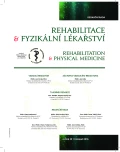Congenital Synostosis of Vertebras C4 a C5
Authors:
R. Bednár 1; V. Kubinec 2; G. Majeríková 1
Authors‘ workplace:
Oddelenie fyziatrie balneológie a liečebnej rehabilitácie, FNsP F. D. Roosevelta, Banská Bystrica
1; Ortopedická klinika, FNsP F. D. Roosevelta, Banská Bystrica, primár MUDr. G. Majeríková
2
Published in:
Rehabil. fyz. Lék., 23, 2016, No. 4, pp. 213-216.
Category:
Case Report
Overview
Congenital anomalies in cervical spine are relatively rare. Bony continuity results from failure of normal segmentation of the vertebral somites at the preosseous stage during embryonic development. The fusion can occur in the body or in the back part or in both parts of the vertebra. In these cases, the intervertebral disc may be completely absent or may appear as a rudimentary structure. In our case report we describe a case of a 39 year old female working in assembly-line production with C4-5 cervical synostosis and C6 compressive cervicobrachial syndrome on the left. The C4-5 congenital cervical synostosis itself is clinically silent and problems will only begin with development of degenerative changes in the segment under the synostosis. Hypermobile C5-6 section is subject to more rapid degeneration. In our patient’s case, static one-sided work overload of the most stressed segment under the stenosis even accelerated the degeneration and gave rise to C6 root compression syndrome on the left on the basis of the intervertebral disc herniation. Though she was without difficulties after conservative treatment lasting one and a half months, yet she remained very risky. We recommended changing her job, modifying her lifestyle, completing a spa treatment and adhering to vertebrogenic regime. The patient neglected our recommendations and has continued in the same job. It resulted in a decompensation with the necessity of the anterior C5-6 discectomy with rigid disc replacement. We believe that patients with cervical C4-5 synostosis when exposed to regular manual and one-sided load are at higher risk. In the case of diagnosis of cervical spine vertebral synostosis, muscle dysbalance compensation is crucial in the prevention of early discopathy. Preventive measures include an assessment of workload and, according to development of the disease, also job change.
Keywords:
cervical spine block, cervical spine synostosis, cervical spine congenital block, C4-C5 synostosis
Sources
1. ALTUNKAS, A., SARIKAYA, B.: Multiple congenital vertebral anomalies identified with multidetector CT. Int. J. Anat.Var., roč. 2, 2009, s. 2-3.
2. ERDIL, H., YILDIZ, N., CIMEN, M.: Congenital fusion of cervical vertebrae and its clinical significance. J. Anat. Soc. India, roč. 52, 2003, č. 2, s. 125-127.
3. KUKLÍK, M., MAŘÍK, I., KOZLOWSKY, K.: Vrozené deformity páteře u genetických syndromů: okulo-aurikulo-vertebrální spektrum. Pohyb. Ústr., roč. 13, 2006, Suppl. č. 1-2, s. 119-128.
4. KULKARNI, V., RAMESH, B. R.: A spectrum of vertebral synostosis. Int. J. Basic Appl. Med. Sci., roč. 2, 2012, č. 2, s. 71-77.
5. MOON, M. S., KIM, S. S., YOON, M. G., SEO, Y. H., LEE, B. J., MOON, H., KIM, S. S.: Radiographic assessment of effect of congenital monosegment synostosis of lower cervical spine between C2-C6 on adjacent mobile segments. Asian Spine J., roč. 8, 2014, č. 5, s. 615-623.
6. SCHER, A. T.: Cervical vertebral dislocation in rugby player with congenital vertebral fusion. Br. J. Sports. Med., roč. 24, 1990, č. 3, s. 167-168.
7. SCHER, A. T.: Cervical spine fusion and the effects of injury. S. Afr. Med. J., roč. 56, 1979, č. 13, s. 525-527.
8. STŘEDA, A.: Ankylóza k loubů a oblouků na krční páteři při juvenilní revmatoidní artritide a její diferenciální diagnostika v dospělosti. Rheumatologia, roč. 2, 1988, č. 3, s. 169-173.
9. USHER, B. M., CHRISTENSEN, M. N.: A sequential developmental field defect of the vertebrae, ribs and sternum in a young woman of the 12th century AD. Am. J. Phys. Anthropol., roč. 111, 2000, č. 3, s. 355-367.
10. VADGAONKAR, R., MURLIMANJU, B. V., PAI, M. M., PRAB-HU, L. V., GOVES, A. A., KUMAR, S.: Cervical spine synostosis: an anatomical study with emphasis on embryological and clinical aspects. Clin. Ter., roč. 163, 2012, č. 6, s. 463-466.
Labels
Physiotherapist, university degree Rehabilitation Sports medicineArticle was published in
Rehabilitation & Physical Medicine

2016 Issue 4
- Hope Awakens with Early Diagnosis of Parkinson's Disease Based on Skin Odor
- Deep stimulation of the globus pallidus improved clinical symptoms in a patient with refractory parkinsonism and genetic mutation
Most read in this issue
- Congenital Synostosis of Vertebras C4 a C5
- The Relation between Stress, Psychoneurotic Symptoms and Traits, and Neck Pain
- Functional Independence Measure as an Indicator of Patient Disability - Evaluation of Practical Experiences
- CI therapy – a Chance for Chronic Patients after Brain Damage
